

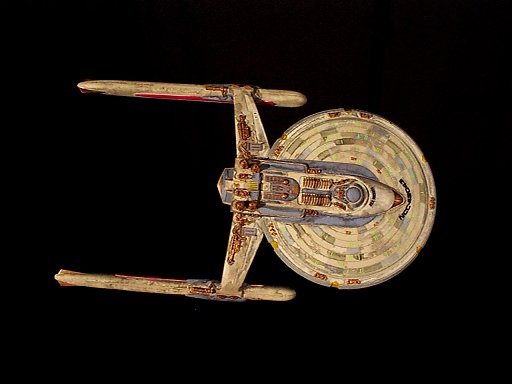 At the turn of the 24th Century, Starfleet had three main classes of frigate: the Phobos class, Apollo class, and Okinawa class. Patrol forces, of which frigates are a large portion, are the mainstay of Starfleet, tasked with patrolling frontiers, guarding neutral zones, protecting commercial freighter traffic, and preventing piracy and smuggling. Often a frigate will be the first command of a Command-track Starfleet officer of rank Lieutenant Commander or Commander.
At the turn of the 24th Century, Starfleet had three main classes of frigate: the Phobos class, Apollo class, and Okinawa class. Patrol forces, of which frigates are a large portion, are the mainstay of Starfleet, tasked with patrolling frontiers, guarding neutral zones, protecting commercial freighter traffic, and preventing piracy and smuggling. Often a frigate will be the first command of a Command-track Starfleet officer of rank Lieutenant Commander or Commander.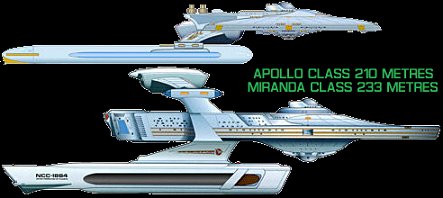 The Apollo class is continuing its cycle of production, intended to replace the aging Saladin design and its variants in their frontline policing roles. Apollo-class starships do not have the full range and capabilities of even their Okinawa-class stablemates, but as a specialised anti-smuggling vessel they can punch above their weight in the modern galaxy. Armed with fifty photon torpedoes and state-of-the-art phaser systems, along with the best sensors Starfleet could install, the Apollo-class was the Starfleet reply to Klingon Bird of Prey flotillas, the threat of ever-increasing Romulan border probes before the Tomed Incident, and the continually increasing sophistication of smugglers, pirates, and organised crime.
The Apollo class is continuing its cycle of production, intended to replace the aging Saladin design and its variants in their frontline policing roles. Apollo-class starships do not have the full range and capabilities of even their Okinawa-class stablemates, but as a specialised anti-smuggling vessel they can punch above their weight in the modern galaxy. Armed with fifty photon torpedoes and state-of-the-art phaser systems, along with the best sensors Starfleet could install, the Apollo-class was the Starfleet reply to Klingon Bird of Prey flotillas, the threat of ever-increasing Romulan border probes before the Tomed Incident, and the continually increasing sophistication of smugglers, pirates, and organised crime.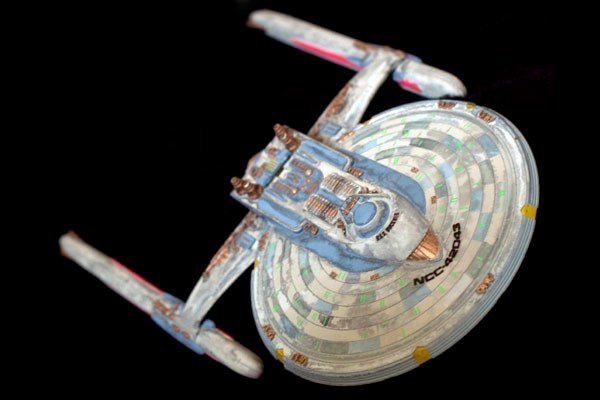 Apollo class frigate specifics:
Apollo class frigate specifics:| Name | Starship Registry | Notes | Author's Notes |
| Apollo | 9173 | Prototype. | |
| Achilles | 11771 | ||
| Abderus | Companion of Hercules | ||
| Aegis | Shield of Zeus | ||
| Aeolus | 42041 | King of the Winds | |
| Agamemnon | 11638 | King of Argos | |
| Ajax | 11574 | Cortin Zweller's first assignment in 2327. | TNG "Tapestry" |
| Amazon | 11 | ||
| Andromeda | 11047 | ||
| Antaeus | 11 | Wrestler slain by Hercules | |
| Aphrodite | 11 | ||
| Arachne | 11 | ||
| Arethusa | 11038 | Nymph changed to fountain | |
| Artemis | 11712 | Diana the Huntress | |
| Aurora | 11 | Eos | |
| Avalon | 11 | Isle where King Arthur is laid to rest | |
| Bacchante | 11069 | ||
| Callisto | 11 | Arcadian nymph | |
| Cassandra | 11 | Daughter of Priam | |
| Cassiope | 11 | Mother of Andromeda | |
| Castor | 11 | ||
| Centaur | 42043 | DS9 | |
| Cerberus | 11221 | ||
| Cerynitis | 11 | A sacred stag | |
| Chalybes | 11 | Race of iron forgers | |
| Charybdis | 11475 | ||
| Chimera | |||
| Chloris | 11 | Flower goddess | |
| Clement | 12537 | TNG "Lower Decks" | |
| Cyclops | 11 | ||
| Cygnus | 11 | ||
| Danae | 11247 | ||
| Deianira | 11 | Wife of Hercules | |
| Diomede | 11016 | ||
| Dido | 11037 | ||
| Dionysus | 11 | Bacchus | |
| Electra | 11227 | Daughter of Oceanus | |
| Epeus | 11 | Maker of the Trojan Horse | |
| Eurydice | 11 | ||
| Gage | 11672 | Lost at Wolf 359. | DS9 "Emissary" |
| Galatea | 11699 | Statue of Pygmalion | |
| Gorgon | 11 | ||
| Hector | 11 | Champion of Troy | |
| Hephaestus | 11 | Vulcan | |
| Hercules | 11 | ||
| Hermione | 11458 | Daughter of Menelaus | |
| Hippolyte | 11 | Queen of the Amazons | |
| Icarus | 11 | ||
| Iolaus | 11 | Nephew of Hercules | |
| Ixion | 11 | ||
| Jason | 11 | Destroyed by the Dominion | |
| Leander | 11109 | named for a class of RN frigates. | |
| Medusa | 11 | ||
| Menelaus | 11300 | King of Sparta | |
| Minotaur | 11 | ||
| Naiad | 11039 | ||
| Nestor | 11 | ||
| Olympia | 11 | ||
| Pandora | 11 | ||
| Penelope | 11127 | ||
| Persephone | 11 | ||
| Perseus | 11 | ||
| Phoebe | 11042 | ||
| Pholus | 11 | A centaur | |
| Polyphemus | 11 | Companion of Hercules | |
| Scylla | 11171 | named for the Daughter of Minos | |
| Sphinx | 11 | ||
| Syrinx | 11 | Nymph turned into reed. | |
| Thor | 11 | ||
| Wells |
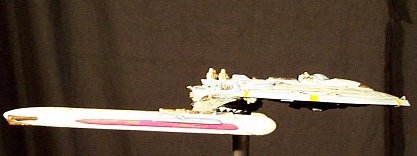 Author's Notes:
Author's Notes: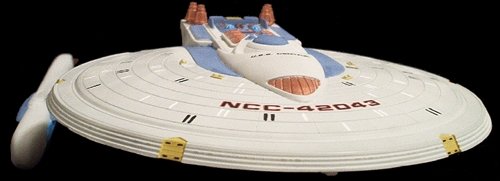 One of the greatest debates about the Centaur was the size. The DS9TM states 381 metres which makes her Excelsior saucer sized hull and nacelles with an impossibly big bridge and torpedo pod, not to mention top windows that would be three decks in length(!). A smaller size which is compatible with the dorsal windows, bridge and torpedo pod is the alternative chosen here and also finally agreed upon by Bernd Scneider of Ex Asteris Scientia - 210 metres as opposed to 381.
While originally opposed to the 210m frigate and preferring the 381m light cruiser, a conversation with the Centaur's creator has firmly ended the debate. Adam Buckner designed the ship from the outset to be scaled to her Miranda hull pieces as a small, fast, deep space prowler.
One of the greatest debates about the Centaur was the size. The DS9TM states 381 metres which makes her Excelsior saucer sized hull and nacelles with an impossibly big bridge and torpedo pod, not to mention top windows that would be three decks in length(!). A smaller size which is compatible with the dorsal windows, bridge and torpedo pod is the alternative chosen here and also finally agreed upon by Bernd Scneider of Ex Asteris Scientia - 210 metres as opposed to 381.
While originally opposed to the 210m frigate and preferring the 381m light cruiser, a conversation with the Centaur's creator has firmly ended the debate. Adam Buckner designed the ship from the outset to be scaled to her Miranda hull pieces as a small, fast, deep space prowler.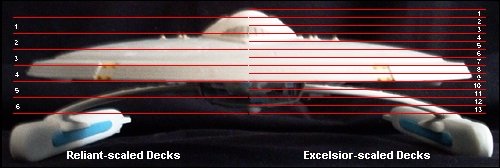 From Bernd Schneider's website, the comparison to Reliant sized parts gave a total of six decks. This matches up with the eleven decks that the Miranda class has. This is a frigate, not a cruiser-sized object and the saucer section is small. The ship will only have the bare basics for science and research, being geared more for the practical purposes of border patrol and anti-smuggling duties. This is very similar to the Royal Navy River-class Offshore Patrol Vessels (O.P.V.) Tyne, Mersey, Severn, and the larger Clyde. These ships look after the merchant trade that keeps the Federation going, they stop the smugglers, the pirates, the drug and people traffickers. These are the equivalents of the Australian Navy Armidale class - just like HMAS Hammersley in Sea Patrol.
From Bernd Schneider's website, the comparison to Reliant sized parts gave a total of six decks. This matches up with the eleven decks that the Miranda class has. This is a frigate, not a cruiser-sized object and the saucer section is small. The ship will only have the bare basics for science and research, being geared more for the practical purposes of border patrol and anti-smuggling duties. This is very similar to the Royal Navy River-class Offshore Patrol Vessels (O.P.V.) Tyne, Mersey, Severn, and the larger Clyde. These ships look after the merchant trade that keeps the Federation going, they stop the smugglers, the pirates, the drug and people traffickers. These are the equivalents of the Australian Navy Armidale class - just like HMAS Hammersley in Sea Patrol.











